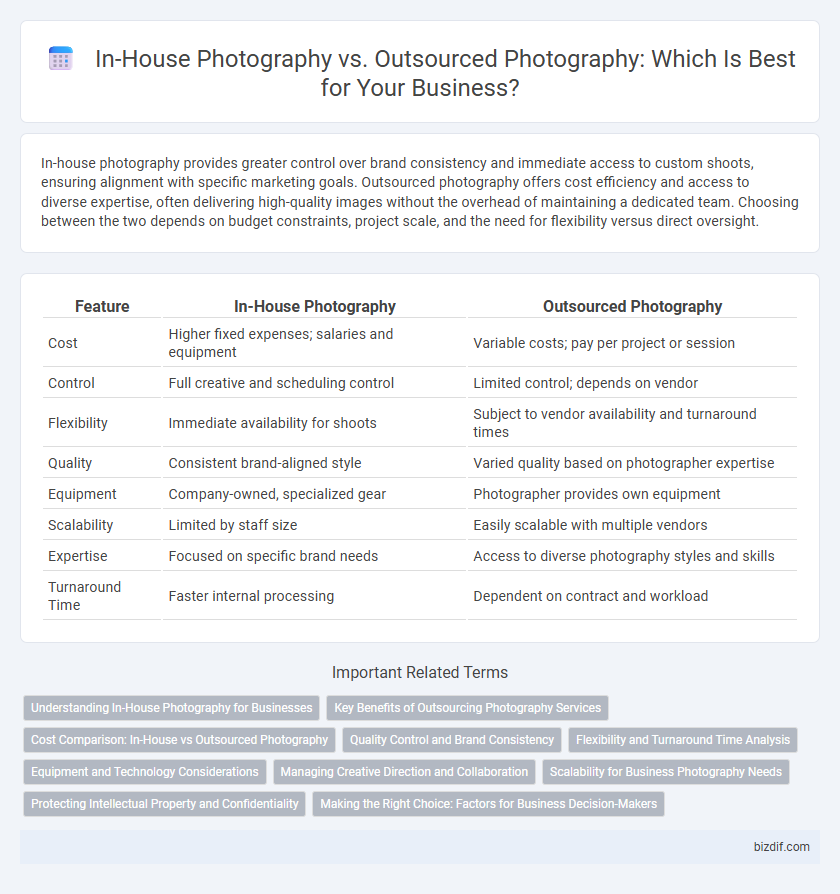In-house photography provides greater control over brand consistency and immediate access to custom shoots, ensuring alignment with specific marketing goals. Outsourced photography offers cost efficiency and access to diverse expertise, often delivering high-quality images without the overhead of maintaining a dedicated team. Choosing between the two depends on budget constraints, project scale, and the need for flexibility versus direct oversight.
Table of Comparison
| Feature | In-House Photography | Outsourced Photography |
|---|---|---|
| Cost | Higher fixed expenses; salaries and equipment | Variable costs; pay per project or session |
| Control | Full creative and scheduling control | Limited control; depends on vendor |
| Flexibility | Immediate availability for shoots | Subject to vendor availability and turnaround times |
| Quality | Consistent brand-aligned style | Varied quality based on photographer expertise |
| Equipment | Company-owned, specialized gear | Photographer provides own equipment |
| Scalability | Limited by staff size | Easily scalable with multiple vendors |
| Expertise | Focused on specific brand needs | Access to diverse photography styles and skills |
| Turnaround Time | Faster internal processing | Dependent on contract and workload |
Understanding In-House Photography for Businesses
In-house photography allows businesses to maintain complete control over brand consistency and creative direction by employing dedicated photographers familiar with the company's vision and products. It facilitates faster turnaround times and enables immediate adjustments to shoots, ensuring alignment with marketing goals. Investing in in-house teams can improve quality assurance and foster deeper collaboration across departments, enhancing overall visual storytelling effectiveness.
Key Benefits of Outsourcing Photography Services
Outsourcing photography services offers access to specialized expertise and state-of-the-art equipment without the overhead costs of maintaining an in-house team. Professional external photographers bring diverse styles and fresh perspectives that enhance brand image and ensure high-quality visual content. Flexible scaling options allow businesses to efficiently manage photography needs based on project demands, optimizing budget and time management.
Cost Comparison: In-House vs Outsourced Photography
In-house photography typically incurs fixed costs including salaries, equipment, and studio maintenance, which can be cost-effective for businesses with high and consistent photography needs. Outsourced photography offers variable pricing based on project scope, often reducing expenses for small or occasional shoots by eliminating overhead costs. Companies must analyze volume, quality requirements, and budget constraints to determine the most financially advantageous option between in-house and outsourced photography services.
Quality Control and Brand Consistency
In-house photography offers direct control over quality standards and ensures brand consistency through close alignment with the company's visual identity and message. Outsourced photography can introduce variability in quality and challenges in maintaining a unified brand style due to varying photographer interpretation and less frequent communication. Establishing clear guidelines and frequent reviews is essential when outsourcing to uphold the brand's visual integrity and meet quality expectations.
Flexibility and Turnaround Time Analysis
In-house photography teams offer greater flexibility, allowing for immediate adjustments during shoots and faster response to last-minute changes, which is critical for dynamic project requirements. Outsourced photography may have longer turnaround times due to scheduling constraints and external approvals, potentially delaying deliverables in fast-paced environments. Businesses prioritizing rapid project execution and on-demand modifications typically benefit from in-house solutions, whereas outsourced photography suits standardized workflows with less urgent timelines.
Equipment and Technology Considerations
In-house photography teams benefit from direct control over specialized equipment investments and ongoing technology upgrades tailored to specific project needs. Outsourced photography often provides access to advanced, industry-standard gear without the capital expense, enabling businesses to leverage cutting-edge cameras, lighting, and editing tools. Evaluating equipment compatibility, maintenance costs, and technological capabilities is crucial when deciding between in-house and outsourced photography solutions.
Managing Creative Direction and Collaboration
Managing creative direction in in-house photography allows for immediate feedback and seamless collaboration within the team, ensuring consistent brand vision and faster project turnaround. Outsourced photography offers access to specialized expertise and diverse creative perspectives but requires clear communication protocols and defined deliverables to align with brand goals. Effective collaboration in either model depends on establishing structured workflows, regular check-ins, and utilizing project management tools to maintain creative coherence and meet deadlines.
Scalability for Business Photography Needs
In-house photography offers businesses direct control and consistent branding but may struggle with scalability during peak project demands due to limited internal resources. Outsourced photography provides flexible scalability by accessing diverse experts and equipment on demand, enabling efficient handling of fluctuating volumes and specialized shoots. Choosing the right model depends on balancing cost, quality consistency, and the ability to scale to meet seasonal or campaign-specific business photography needs.
Protecting Intellectual Property and Confidentiality
In-house photography ensures direct control over intellectual property rights, minimizing risks of image misuse or unauthorized distribution within a secure environment. Outsourced photography may expose confidential content to external parties, necessitating robust contractual agreements and non-disclosure clauses to safeguard proprietary assets. Protecting brand integrity and proprietary visuals is critical, making the choice between in-house and outsourced photography pivotal for maintaining confidentiality and intellectual property security.
Making the Right Choice: Factors for Business Decision-Makers
Business decision-makers must evaluate cost efficiency, quality control, and scalability when choosing between in-house photography and outsourced services. In-house photography offers greater brand consistency and immediate project turnaround, while outsourcing provides access to specialized talent and reduced overhead. Prioritizing alignment with company goals, project complexity, and budget constraints ensures an informed and effective photography strategy.
In-House Photography vs Outsourced Photography Infographic

 bizdif.com
bizdif.com